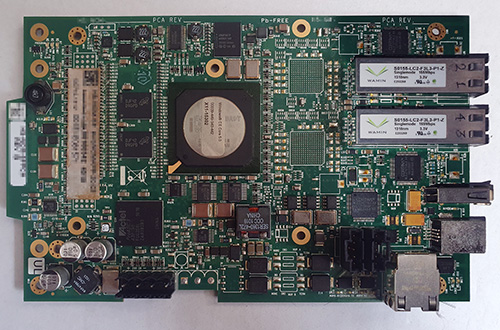The ware for March 2021 is shown below.
This is an interesting ware that made its way to my inbox via a person who wishes to be credited as simply “Lih”.
I definitely had a bit of trouble guessing its purpose, but certain strange things started to make more sense once I found out. I wonder how quickly others will pick up on the oddities, and piece it together!

Optical transceivers, 24V in/out (for driving a motor?), some fat connectors surrounded by RX/TX labeled diodes. I’m going to guess it’s a controller board for a satellite dish with the hardware required for digital transmission. The odd thing is the fat SOC/CPU proudly announcing its Windows CE capability, so I will just guess it’s there to offer some management interface.
Hmm, okay, we’ve got:
A big Intel SoC. It’s got some DRAM as well.
There’s three 100Mb/s Ethernet jackes. One copper, and two optical (The Cortina WJLXT971ALEA4.are 100Mb/s Ethernet PHY).
24V in and out.
USB A host and B device ports.
A small ASIC (Alcatel ProASIC 3)
Two 1×5 clip in headers (debugging?)
Date codes in the 2010-2011 range.
My guess is a Honeywell Notifier ONYXWorks NFN Gateway-3 NFN-GW-EM-3
I think we have a winner here. Pictures online show the exact same board (not always with its transceivers.). Still wondering how you got from 3 ethernet + windows CE + asic to a fire monitoring workstation. Oh well.
I saw the unpopulated jack next to the optical ethernet and first USB (A- Host) connecotor. It’s labeled NFN. I have never heard of an NFN port, so I went searching. I found a Nasdaq protocol which sort of made sense, but more searching brought up NOTI*FIRE*NET and that lead quickly to the board in question.
There were a few side trips to Cortina systems, but they turned out to be boring Ethernet PHY makers. I was hoping they’d be some industry specific protocol chips, but that didn’t pan out.
I found this product sheet: https://www.securityandfire.honeywell.com/-/media/Files/Notifier/Data-Sheets/DN_60499_pdf.pdf
and the image looked spot on–as you mentioned, it was missing the optical tranceivers and there was a huge connector where the board here just has a sticker.
Oh, and there was some side quest to figure out the Intel chip, but that didn’t turn up anything useful, either. I though it might be an ASIC with an ARM core, but I think it’s probably and x86 SoC. I’d still love to see what’s under the WindowsCE sticker!
Googling for NUP connector after spotting the silkscreen labels on the bottom right led me to the same datasheet.
That SoC is an Intel ixp460 or ixp465.These are fairly generic networking chips with multiple ethernet ports (mii/smii) and syncrhonous serial ports that can be used for WAN interfaces such as a DSL access multiplexer (DSLAM). The 155MBps interface could also be for some STM or ATM based WAN.
So this is an ARM-core from the Xscale era. Haven’t seen one of these for quir some time.
They are still in use in a lot of places, and supported by mainline Linux. The most notable thing about them is that this is the only Arm platform I’m aware of that was normally shipped to run big-endian software. The common thinking back then was that network-centric hardware should run big-endian because that is what the IP protocols do, and what all the common network infrastructure (powerpc, parisc, sparc, early mips …) did anyway.
Like most Arm SoCs, the ixp4xx hardware can actually run either in big-endian and little-endian mode, but everyone else running Linux usually went for little-endian, inluding the other XScale (PXA handhelds, IOP storage processors). Windows CE never had support for big-endian mode on any hardware at all, so this particular machine did run in LE mode, as would anyone running a non-anciant Debian distro.
Hi,
It is a Honeywell Notifier HS-NCM-MF High speed Network Card.
Looks more like a HS-NCM-WSF-2 as it has both wired and *single mode* fiber.
Actually I’d say it looks more like the HS-NCM-SF based on the dual singlemode connectors.
There are some greats shots of the MF board at https://www.ebay.com/itm/141999875171